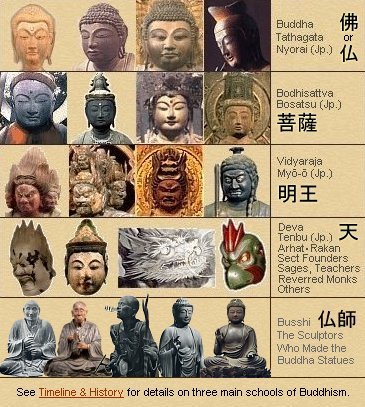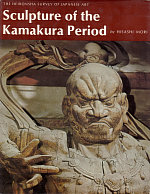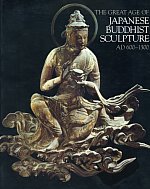|
|
|
|
|

Bukkyō 仏教
Japanese for Buddhism
Literally “Teachings of Buddha
|
|
 TEACHER’S CONDENSED GUIDE TEACHER’S CONDENSED GUIDE
Japanese Buddhism & Buddhist Statuary
Integrated Guide to Buddhism
and Buddhist Statuary in Japan
Your launch pad into the history & development
of Buddhism and Buddhist artwork in Japan.

WHO’S WHO
CLASSIFYING BUDDHIST DEITIES
Standard Classification in Japan
Most Deities Originated in India
Click any group in below image to get started.

 Pending Pages Pending Pages
- What is Japanese Taoism?
- What are the main sects of Japanese Buddhism?
- Who are the founders of Japan’s main Buddhist sects?
- What are the objects held or worn by the Buddhist deities?
- What are the main sutras / texts of Japanese Buddhism?
- Why are there so many Buddhist deities?
- Heian Era Photo Tour, Kamakura Era Photo Tour, etc.
- Japanese Funerals and Concepts of Hell
- Japanese Weddings and Other Common Ceremonies
- Special Court Rituals and Major National Ceremonies

|

卍. A symbol originating in India. Known as the Kyoji 胸字 (Kyōji) in Japan. Found frequently in India on the chest of Lord Vishnu. In Japan it is used as a symbol of Buddhist faith, one found frequently on statues of the Buddha (Jp. = Nyorai 如来) and Bodhisattva (Jp. = Bosatsu 菩薩), and one of the 32 Marks of the Buddha (Sanjūnisō 三十二相). It represents the ”possession of all virtues” in Japanese Buddhism. See Footprints of Buddha for more.
|
|
 What is Buddhism? Buddhism originated in India around 500 BCE. Called Bukkyo (Bukkyō) 仏教 in Japanese, Buddhism is a philosophical system of rigorous mental and physical practice that attempts to end all suffering, pain, and karmic rebirth by adherence to strict ethical and spiritual guidelines. Founded by Gautama Siddhartha, who forsook his royal life, family, and society in a quest to eliminate material desires and mundane concerns. After achieving enlightenment, he was called Shaka Buddha 釈迦如来 (the Historical Buddha). See Guide to the Teachings of Buddha to explore the main tenets of his philosophy. What is Buddhism? Buddhism originated in India around 500 BCE. Called Bukkyo (Bukkyō) 仏教 in Japanese, Buddhism is a philosophical system of rigorous mental and physical practice that attempts to end all suffering, pain, and karmic rebirth by adherence to strict ethical and spiritual guidelines. Founded by Gautama Siddhartha, who forsook his royal life, family, and society in a quest to eliminate material desires and mundane concerns. After achieving enlightenment, he was called Shaka Buddha 釈迦如来 (the Historical Buddha). See Guide to the Teachings of Buddha to explore the main tenets of his philosophy.
Buddhism swept quickly (some 1000 years) across Asia, splitting into three main schools as it evolved. It came last to Japan, crossing the sea from Korea around 552 AD. The Mahayana form in particular gained the patronage of Japan’s imperial court and nobility, thus the majority of surviving Buddhist sculpture in Japan today belongs to the Mahayana tradition. Artwork belonging to the Theravada and Vajrayana (Esoteric) traditions is less prominent, but it is nonetheless plentiful. Sects from all three schools are still active in Japan, but Mahayana Buddhism remains the most popular form. Buddhism remained confined largely to the nobility and imperial court until the 13th century, but thereafter it spread rapidly among the common people. Despite early conflict with the native Shinto faith, Buddhism soon gained acceptance and developed alongside Shinto in a great syncretic merger, one generally marked by religious tolerance. Elements of Hinduism インド教 (Indokyō), Taoism 道教 (Dōkyō), and Confucianism 儒教 (Jukyō) were also eagerly adopted by the Japanese, as was China’s Zodiac calendar 干支 (Kanshi or Eto). Today, Japanese Buddhism is a rich tapestry of beliefs, rituals, and superstitions that incorporates all these diverse elements.

 Why did Japan absorb then assimilate Buddhism? Why did Japan absorb then assimilate Buddhism?
Buddhism was adopted by Japan’s rulers primarily to establish social order and political control, and to join the larger and more sophisticated cultural sphere of the mainland. Buddhism brought new theories on government, a means to establish strong centralized authority, a system for writing, advanced new methods for building and for casting in bronze, and new techniques and materials for painting. Buddhism’s introduction to Japan in +552 was accompanied by the arrival thereafter of countless artisans, priests, and scholars from Korea and China, with numerous Japanese missions dispatched to the mainland. Japan first learned of Buddhism from Korea, but the subsequent development of Japanese Buddhism and Buddhist sculpture was primarily influenced by China. According to tradition, Buddhism was introduced to Japan in +552 (other sources say +538) when the king of the Korean Kingdom of Paekche (Jp. = Kudara 百済) sent the Japanese Yamato 大和 court a small gilt bronze Buddha statue, some Buddhist scriptures, and a message praising Buddhism. Scholars continue to disagree on the exact date of the statue’s arrival. The Nihonshoki 日本書紀, one of Japan’s oldest extant documents, says the statue was presented sometime during the reign of Emperor Kinmei 欽明 (ruled from + 539 to 571). For details, see Early Japanese Buddhism. In addition, Buddhism represented a superior religious philosophy compared to the shamanistic mountain worship of the indiginous Shinto faith. Not surprisingly, Buddhism gained the patronage of the court, who endeavored to use it as both a political and spiritual tool for building a stronger nation.
One of the first great patrons of Buddhism in Japan was Prince Shotoku Taishi 聖徳太子 (+ 574 - 622). He embraced the new faith and fostered its acceptance as both a superior religious philosophy and a powerful political tool for creating strong centralized governance under the emperor’s guidance. Shotoku (Shōtoku) is credited with constructing numerous temples, and with centralizing state administration, importing Chinese bureaucracy, codifying twelve court ranks, and enacting a 17 Article Constitution that established Buddhist ethics and Confucian ideals as the moral foundations of the young Japanese nation. During his regency, Japanese missions (outside link) were dispatched to China to learn more and bring back valuable Buddhist texts and objects. In addition to court patronage, another reason for Japan’s embrace of Buddhism involved the notion of “building spiritual merit” for oneself and others. Known as Chishiki (知識) in Japanese and translated as “pious contribution.” Originally a Sanskrit term (mitra) meaning “friend” or “companion,” in Japan it came to designate any person who spread the Buddhist teachings in hopes of saving others. Chishiki was a means to accumulate religious and spiritual merit and thus improve one’s own chance of salvation. It came in many forms, from those who founded and maintained temples, to those who devoted their money, land, or efforts to advance the cause of Buddhism. The Chishiki ideal came to prominence with Emperor Shomu 聖武 (Shōmu; reigned +724 to 749) in Japan’s Nara period. Shomu ordered the construction of a giant bronze Buddha statue, one to be financed by the “pious contributions” of devotees, parishioners, and lay people. The “chishiki” ideal meant that the benefits of contructing and maintaining the giant statue would accrue to anyone who participated in the endeavor, no matter how small their contribution. The concept resonated deeply among Japan’s nobility and common people. Even today, the Chishiki ideal remains a major pillar of Buddhist practice in Japan.

ENGLISH RESOURCES
- JAANUS. Japanese Architecture & Art Net Users System. In my mind, JAANUS is the best online database available on Japanese art history. Compiled by the late Dr. Mary Neighbour Parent, it covers both Buddhist and Shinto deities in great detail and contains over 8,000 entries.
- Dr. Gabi Greve. See her page on Japanese Busshi. Gabi-san did most of the research and writing for the Edo Period through the Modern era. She is a regular site contributor, and maintains numerous informative web sites on topics from Haiku to Daruma. Many thanks Gabi-san !!!!
  Heibonsha, Sculpture of the Kamakura Period. By Hisashi Mori, from the Heibonsha Survey of Japanese Art. Published jointly by Heibonsha (Tokyo) & John Weatherhill Inc. A book close to my heart, this publication devotes much time to the artists who created the sculptural treasures of the Kamakura era, including Unkei, Tankei, Kokei, Kaikei, and many more. Highly recommended. 1st Edition 1974. ISBN 0-8348-1017-4. Buy at Amazon Heibonsha, Sculpture of the Kamakura Period. By Hisashi Mori, from the Heibonsha Survey of Japanese Art. Published jointly by Heibonsha (Tokyo) & John Weatherhill Inc. A book close to my heart, this publication devotes much time to the artists who created the sculptural treasures of the Kamakura era, including Unkei, Tankei, Kokei, Kaikei, and many more. Highly recommended. 1st Edition 1974. ISBN 0-8348-1017-4. Buy at Amazon . .
- Classic Buddhist Sculpture: The Tempyo Period. By author Jiro Sugiyama, translated by Samuel Crowell Morse. Published in 1982 by Kodansha International. 230 pages and 170 photos. English text devoted to Japan’s Asuka through Early Heian periods and the development of Buddhist sculpture during that time. ISBN-10: 0870115294. Buy at Amazon.

  The Great Age of Japanese Buddhist Sculpture, AD 600-1300. By Nishikawa Kyotaro and Emily J Sano, Kimbell Art Museum (Fort Worth) and Japan House Gallery, 1982. 50+ photos and a wonderfully written overview of each period. Includes handy section on techniques used to make the statues. The Great Age of Japanese Buddhist Sculpture (AD 300 - 1300) The Great Age of Japanese Buddhist Sculpture, AD 600-1300. By Nishikawa Kyotaro and Emily J Sano, Kimbell Art Museum (Fort Worth) and Japan House Gallery, 1982. 50+ photos and a wonderfully written overview of each period. Includes handy section on techniques used to make the statues. The Great Age of Japanese Buddhist Sculpture (AD 300 - 1300) . .
- Epochs of Chinese and Japanese Art by Ernest F. Fenollosa, published by ICG Muse Inc. ISBN 4-925080-29-6. English. Originally published in 1912, but new edition in 2000. Highly recommended book on Buddhist sculpture in Japan. Although Fenollosa's views on art history are often discredited by modern art historians, this is still an excellent book on Buddhist sculpture in Japan.
- Ernest Fenollosa, "The Coming Fusion of East and West." Harper's New Monthly Magazine. 98, December 1898
- Ernest Fenollosa, The Chinese Written Character as a Medium for Poetry. Ed. Ezra Pound. San Francisco: City Lights Books, 1936

  JAPANESE BOOKS JAPANESE BOOKS
- Comprehensive Dictionary of Japan's National Treasures. (国宝大事典 (西川 杏太郎). Published by Kodansha Ltd. 1985. 404 pages, hardcover, over 300 photos, mostly color, many full-page spreads. Japanese Language Only. ISBN 4-06-187822-0.
- Bosatsu on Clouds, Byodo-in Temple. Catalog, May 2000. Published by Byodoin Temple. Produced by Askaen Inc. and Nissha Printing Co. Ltd. 56 pages, Japanese language (with small English essay). Over 50 photos, both color, B&W. Some photos at this site were scanned from this book. Of particular use when studying the life and work of Jocho Busshi.
- Visions of the Pure Land: Treasures of Byodo-in Temple
Catalog, 2000. Published by Asahi Shimbun. Artwork from Byodo-in Temple. 228 pages, Japanese language with English index of works. Over 100 photos, color and B&W. Some photos at this site were scanned from this book. No longer in print. Of particular use when studying the life and work of Jocho Busshi.
- Numerous Japanese-language temple and museum catalogs, magazines, books, and web sites. See Japanese Bibliography for extended list.
JAPANESE WEB SITES
CHINESE WEB SITES

ONLINE STORE SELLING BUDDHA STATUES
Buddhist-Artwork.com, our sister site, launched in July 2006. This online store sells quality hand-carved wooden statues of many Buddhist deities, especially those carved for the Japanese market. It is aimed at art lovers, Buddhist practitioners, and laity alike. Just like this site (OnmarkProductions.com), it is not associated with any educational institution, private corporation, governmental agency, or religious group.


This Page First Published Sept. 8, 2007
|
|